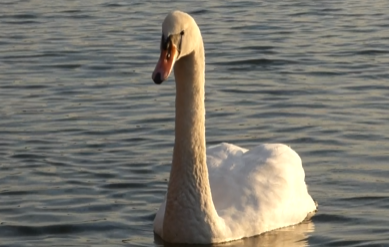Cygnus spp. (Swan)
Description:
The swan is a large aquatic bird belonging to the Anatidae family. It is known for its elegance, with a long, curved neck and an imposing body covered in white or black feathers, depending on the species. The beak varies in color, from black to orange or red, often featuring a distinctive knob at the base. Swans are symbols of grace and purity in many cultures and exhibit territorial behavior during the breeding season. They are excellent swimmers and, despite their size, capable of flying long distances.
Scientific Classification:
- Kingdom: Animalia
- Phylum: Chordata
- Class: Aves
- Order: Anseriformes
- Family: Anatidae
- Genus: Cygnus
- Major species:
- Cygnus olor (Mute Swan)
- Cygnus cygnus (Whooper Swan)
- Cygnus columbianus (Tundra Swan)
- Cygnus atratus (Black Swan)
- Cygnus buccinator (Trumpeter Swan)

Dimensions and Weight:
Swans are among the largest waterfowl. Depending on the species, body length ranges from 120 to 170 cm, with a wingspan exceeding 230 cm. Their weight varies from 7 to 15 kg, with males generally being larger than females. Cygnus buccinator is the largest swan, while Cygnus columbianus is the smallest.
Habitat:
Swans inhabit lakes, rivers, ponds, and wetlands, favoring calm waters with abundant vegetation. They are distributed across Europe, Asia, North America, and Australia. Some species, like the mute swan, are resident, while others, such as the whooper swan, migrate seasonally between breeding and wintering areas.
Behavior and Habits:
Swans are monogamous birds, forming long-term pair bonds. During the breeding season, males become highly territorial and aggressively defend their nests. The female lays 4 to 7 eggs, which she incubates for about 35 days. The cygnets are precocial, capable of swimming shortly after hatching.
Swans are primarily herbivorous, feeding on aquatic plants, algae, and roots, though they may also consume small invertebrates.
Dangers, Enemies, and Threats:
Adult swans have few natural predators, but their eggs and cygnets are vulnerable to foxes, birds of prey, and carnivorous mammals. The greatest threats to swans come from human activities: water pollution, habitat destruction, and fishing nets pose significant dangers. Additionally, in some regions, swans have been hunted for their feathers and meat.
Protected or Endangered Species:
Many swan species are protected under international conservation laws. The mute swan, for example, is safeguarded in various European countries. Some species, like the trumpeter swan, have faced drastic declines but are recovering thanks to reintroduction programs. However, climate change and habitat loss continue to pose challenges to their long-term survival.
References__________________________________________________________________________
Yang L, Wang W, Sun P, Huang S, Gao R, Kong D, Ru W, Wronski T, Zhang G. Extrinsic factors, endocrine mechanisms, and behavioral indicators of migratory restlessness in wintering whooper swans (Cygnus cygnus). Sci Rep. 2021 Jun 16;11(1):12636. doi: 10.1038/s41598-021-92031-3.
Abstract. Extrinsic factors, endocrine mechanisms, and behavioral indicators of migratory restlessness were studied in wintering whooper swans (Cygnus cygnus) in the Sanmenxia Swan National Wetland Park in western Henan Province, central China. First, the fecal glucocorticoid metabolite (FGM) concentration was established and related to mean air temperature or photo period (day length) using simple linear or non-linear regression models. After a model selection procedure, the best fitted model revealed that an increase of FGM concentration was associated with an increase in the squared mean air temperature (R2 = 0.88). Other models showed an increasing FGM concentration to correspond with increasing values of day length, squared day length, and mean air temperature-however without statistical support. In a second step, behavioral frequencies of seven behaviors were condensed into three behavioral principal components (PCs) using principal components analysis. Behavioral PCs largely corresponded to three activity phases described for wintering whooper swans in central China and were correlated with the FGM concentration using Spearman's rank-order correlations. Results revealed a significant correlation between FGM and behavioral PC2 (positive factor loadings from vigilance and preening, negative loading from foraging). Finally, we tested for an effect of behavioral PCs on changes in winter home range size using a set of multiple linear regression models. Results of averaged model parameter estimates showed only the behavioral PC3 (positive factor loadings from fighting and calling, negative loading from locomotion) had a marginal significant effect on home range size. Results confirmed findings of previous studies on migratory restlessness in whooper swans. However, due to the small sample size (N = 15 weeks) the effect of PC3 on home range size was weak and should be viewed with caution.
Kim JH, An CH, Jo JH, Kang TH. Winter breeding of black swan Cygnus atratus in a solar greenhouse with a water pond. Anim Reprod Sci. 2023 Mar;250:107199. doi: 10.1016/j.anireprosci.2023.107199. Epub 2023 Feb 12. PMID: 36827817.
Mi JX, Liu KL, Ding WL, Zhang MH, Wang XF, Shaukat A, Rehman MU, Jiao XL, Huang SC. Comparative analysis of the gut microbiota of wild wintering whooper swans (Cygnus Cygnus), captive black swans (Cygnus Atratus), and mute swans (Cygnus Olor) in Sanmenxia Swan National Wetland Park of China. Environ Sci Pollut Res Int. 2023 Sep;30(41):93731-93743. doi: 10.1007/s11356-023-28876-0.
Liu L, Du C, Sun Y, Li W, Zhang J, Cao L, Gao L. Spring diet and energy intake of tundra swan (Cygnus columbianus) at the Yellow River National Wetland in Baotou, China. PeerJ. 2022 Mar 15;10:e13113. doi: 10.7717/peerj.13113.



